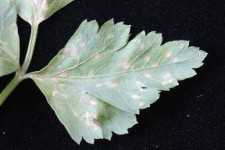Pest Of The Month: Septoria Leaf Spot Of Parsley

Identification
Because of its seedborne nature, the disease can potentially develop on crops under any production system, although those that are overhead watered are more at risk. Septoria species cause disease on other crops of the Apiacae family (e.g., celery), but the host range for each species is limited. For instance, S. petroselini only infects parsley and S. apiicola only infects celery.
Typical early symptoms on parsley and coriander are brown sunken leaf spots sometimes with yellow haloes on leaves and cotyledons. As the leaf spots age, the centers turn tan or light grey and tiny black fungal pycnidia often are visible, which is a useful diagnostic feature for this disease and helps distinguish Septoria leaf spot from the leaf spot caused by Alternaria radicina. When infection is severe, leaves may die and drop off, and lesions may develop on petioles. Pycnidia are sometimes visible on the seed surface but infection may also be more deep-seated within seeds.
Survival And Spread
Septoria from parsley can survive on crop debris and seeds for at least three years and also on volunteer or overwintered plants. There is a risk of cross-infection between neighboring crops (e.g. with sequential planting).
Crops are most at risk after long periods of leaf wetness, particularly at warm temperatures and high relative humidity. Disease development is highly dependent on the presence of water for the pycnidia to swell and release spores, for splash dispersal of spores between plants and for leaf infection to occur.
Spores are readily spread by overhead irrigation and also by people and machinery. If an outbreak has been detected, the movement of equipment or workers through the field while the canopy is wet should be minimized.
Management Methods
Use of clean seed is important for disease avoidance. Hot water treatment for control of Septoria on seed is useful but the temperature and soak duration are critical (125°F, 30 minutes) to maintain seed viability.
The use of strobilurin fungicides like azoxystrobin (Amistar, Syngenta Crop Protection), (Headline, BASF) should assist in controlling this disease. Organic growers can use products like potassium bicarbonate (Armicarb 100, Helena Chemical Co.), (Kaligreen, Arysta LifeScience) for control.
0
1
5
Pest Of The Month: Septoria Leaf Spot Of Parsley





